the 2007 Abstract Presentations - Wound Healing Society
the 2007 Abstract Presentations - Wound Healing Society
the 2007 Abstract Presentations - Wound Healing Society
You also want an ePaper? Increase the reach of your titles
YUMPU automatically turns print PDFs into web optimized ePapers that Google loves.
<strong>Abstract</strong>s<br />
56<br />
PREVENTING STAGE IV PRESSURE ULCERS UTILIZING A<br />
SIMULTANEOUS TREATMENT PROTOCOL<br />
Kapil-Pair N., Rennert R., Golinko, M., Kaplan, D., Brem, H.<br />
<strong>Wound</strong> <strong>Healing</strong> and Vascular Biology Laboratory, Department of Surgery,<br />
Columbia University College of Physicians and Surgeons, New York, NY<br />
Background: Stage IV pressure ulcers result in high rates of morbidity and<br />
mortality, and cost billions of dollars in health care expenses annually. Pressure<br />
ulcer progression to stage IV is often viewed as inevitable, especially in elderly<br />
populations with extensive comorbidities.<br />
Hypo<strong>the</strong>sis: Pressure ulcers progression to stage IV can be halted utilizing a<br />
simultaneous, not sequential, treatment protocol.<br />
Methods: 120 consecutive patients with stage II, III or IV IV sacral, trochanteric<br />
or ischial pressure ulcers were placed on a comprehensive simultaneous<br />
wound healing protocol that included: (1) pressure relief, (2) mechanical<br />
debridement, (3) a moist healing environment, (4) nutritional optimization, (5)<br />
weekly digital measurement of wound, (6) elimination of drainage and cellulitis,<br />
(7) and physical <strong>the</strong>rapy. Ulcer progression was tracked for three to eight<br />
weeks.<br />
Results: Zero out of nine stage II, and two out of sixty stage III pressure ulcers<br />
advanced to stage IV. Of <strong>the</strong> two that progressed, <strong>the</strong> first was on a seventy-five<br />
year old patient with an albumin of 1.9 and a history of congestive heart failure.<br />
The o<strong>the</strong>r patient was 45 years old with an albumin level of 2.0. Among <strong>the</strong><br />
sixty-seven patients that did not progress to stage IV, <strong>the</strong> mean age and albumin<br />
level was 64 17.9 and 2.5 0.6; 24 had Diabetes (35.8%), 17 had congestive<br />
heart failure (25.4%), 4 had sepsis (5.9%), 3 had hypertension (4.5%) and 3 had<br />
a previous myocardial infarction (4.5%).<br />
Conclusions: These results show that a comprehensive simultaneous treatment<br />
protocol will prevent pressure ulcer progression to stage IV, even in elderly,<br />
malnourished patients with co-morbid disease. To optimize patient outcomes,<br />
this protocol should be implemented immediately following diagnosis of<br />
pressure ulcers. 5R01LM008443-02 (HB).<br />
Oxygen/Oxidative Stress<br />
Session Number: 46<br />
Monday, April 30, <strong>2007</strong>, 4:00 to 6:00 pm<br />
<strong>Abstract</strong>s 57–65<br />
57<br />
CLINICAL OUTCOMES IN PATIENTS WITH SEVERE<br />
DIABETIC FOOT WOUNDS TREATED WITH OR WITHOUT<br />
HYPERBARIC OXYGEN<br />
George A. Perdrizet, MD, PhD, FACS, Patrick Worth, SSF, Justin Moher,<br />
MSc, Brian Solomon, Caesar Anderson and Christine Shapter<br />
The Hartford Hospital Center for <strong>Wound</strong> <strong>Healing</strong> and Hyperbaric Medicine,<br />
Hartford Hospital, Hartford, CT<br />
Introduction: Efficacy of Hyperbaric Oxygen Therapy (HBO 2 T) for treatement<br />
of diabetic foot ulcers (DFU, Wagner Grade 3 & 4) has been established. We<br />
wish to present our experience in 25 diabetic patients who received HBO 2 Tin<br />
accordance with UHMS Guidelines.<br />
Methods: Clinical series, sequential patients with a DFU (Wagner Grade 3 or<br />
4) that received Z30 HBO 2 T treatments over a 6-week period, and for whom<br />
<strong>the</strong>re was 10 week follow-up. Demographics, wound parameters and vascular<br />
assessments were obtained from <strong>the</strong> patients’ clinical record. Outcomes include<br />
percentage healed/not healed and percentage of amputations (minor and<br />
major) at 10 weeks after completion of HBO 2 T.<br />
Results: A total of 50 patients met inclusion criteria as having a Wagner Grade<br />
3 or 4 DFU, 25 of whom received Z30 HBO 2 T.<br />
DFU- with<br />
HBO 2 T<br />
DFU-without<br />
HBO 2 T<br />
Number of Patients 25 25<br />
Mean age (yrs) 64 14 75 12<br />
Mean wound size (cm 2 )/range 20 22 (0.2–84) 15.4 15 (0.5–46)<br />
Mean initial TCpO 2 (mmHg) RA 31 18 42 22<br />
% healed (No. healed/not healed) 56 (14/11) 32 (8/17)<br />
% amputation (No. amp/not amp) 16 (4/21) 32 (8/17)<br />
58<br />
VASCULAR ASSESSMENT IN CHRONIC WOUND CARE:<br />
EFFECT OF HBO 2 T ON FORECASTING PATIENT<br />
OUTCOMES<br />
George Perdrizet, MD, PhD, FACS, Patrick Worth, Justin Mohr, Brian<br />
Solomon, Caesar Anderson and Christine Shapter<br />
Center for <strong>Wound</strong> <strong>Healing</strong> and Hyperbaric Medicine, Hartford Hospital,<br />
Hartford, CT<br />
Introduction: Vascular evaluation is a critical component to comprehensive<br />
wound care practices. We report our experience using vascular studies (transcutaneous<br />
oxygen tension, TCpO 2 and ankle/brachial index, ABI) for clinical<br />
decision making and demonstrate how <strong>the</strong> use of HBO 2 may effect standard<br />
algorithms currently in place.<br />
Methods: A clinical series, sequential adult patients with chronic lower extremity<br />
wounds during a 3 year period (8/03–8/06). IRB approval was obtained.<br />
Patients were selected if <strong>the</strong>y had had TCpO 2 and/or ABI as part of <strong>the</strong>ir<br />
evaluation and had at least a 10 week follow-up period. Data was extracted<br />
from patients’ clinical records. Patients were grouped according to conventional<br />
definitions using TCpO 2 and ABI parameters. A comparison of data sets<br />
was performed using <strong>the</strong> Fisher Exact test for diachotomous data and Student’s<br />
t test for continuous data. Statistical significance was reached if p 0.05.<br />
Results: A total of 122 adult patients (115 TCpO 2 and 51 ABI measurements).<br />
Patients with ‘‘Inadequate’’ TCpO 2 but having a positive response to oxygen<br />
challenge, experienced a increased healing rate (63% vs 20%) compared to nonresponders.<br />
Patients with ‘‘Inadequate’’ TCpO 2 who had a positive response to<br />
oxygen challenge and received HBO 2 T experienced a 78% healing rate.<br />
Conclusions: Techniques of vascular assessment provide a fair estimate of<br />
patients who are likely to heal, however poor or ‘‘Inadequate’’ TCpO 2 or ABI<br />
do not exclude <strong>the</strong> ability of <strong>the</strong> wound to heal, (i.e., 30% negative predictive<br />
value). Fur<strong>the</strong>rmore, HBO 2 T may improve <strong>the</strong> expected healing rates in<br />
patients with vascular studies deemed ‘‘Inadequate’’ by current standards.<br />
59<br />
CNS OXYGEN TOXICITY: POTENTIAL RISK FACTORS<br />
George Perdrizet, MD, PhD, FACS, Bettina Magliato, and Mike Powers<br />
Center for <strong>Wound</strong> <strong>Healing</strong> and Hyperbaric Medicine, Hartford Hospital,<br />
Hartford, CT<br />
Introduction: We wish to share our experience addressing adverse events (AE)<br />
associated with <strong>the</strong> use of a multiplace hyperbaric oxygen chamber at an urban,<br />
university based, tertiary care hospital. Risk factors for CNS oxygen toxicity<br />
will be reviewed as <strong>the</strong>y relate to this series of patients and <strong>the</strong> role of sleep<br />
deprivation and pediatric age group will be addressed.<br />
Methods: All AE’s are recorded by <strong>the</strong> HBO 2 Medicine program on a daily<br />
basis. AE’s are divided into two categories, Clinical or Technical. Clinical AE’s<br />
include otic barotraumas (TM perforations), pulmonary barotrauma (pneumothorax),<br />
seizure activity, discontinuation of treatment, and mortality within<br />
1 month of completing HBO 2 T. Technical AE’s are fur<strong>the</strong>r subdivided into<br />
personnel or mechanical events and represent any event leading to <strong>the</strong> inability<br />
to provide a clinical treatment at <strong>the</strong> time of request. All patients are examined<br />
by a staff physician, certified in HBO 2 medicine, prior to HBO 2 T.<br />
Results: During <strong>the</strong> 3 year period (8/03–8/06) a total of 6,682 patient treatments<br />
(2,433 chamber compression episodes) were provided. Six seizure<br />
episodes (5 patients, 1 staff member) were observed in 5 adults and one child.<br />
All neurologic evaluations were within normal limits. No patients were found<br />
to have any underlying CNS diseases that pre-dated <strong>the</strong> HBO 2 T. Three<br />
patients chose to complete <strong>the</strong>ir HBO 2 T and did so without subsequent AE.<br />
The incidence of seizure activity for all patient treatments was 5/6,682<br />
exposures = 0.075%.<br />
Conclusions: The incidence of HBO 2 -induced seizures is very low for patients<br />
being treated in a multi-place chamber at a tertiary care hospital. The establishment<br />
of a national database which tracks AE’s is needed.<br />
Conclusion: Diabetic patients treated with HBO 2 T for Wagner’s Grade 3 or 4<br />
foot ulcers had 56% chance of healing and 16% chance of amputation.<br />
Diabetic patients not receiving HBO 2 T had a 32% chance of healing and a<br />
32% chance of amputation.<br />
<strong>Wound</strong> Rep Reg (<strong>2007</strong>) 15 A14–A54 c <strong>2007</strong> by <strong>the</strong> <strong>Wound</strong> <strong>Healing</strong> <strong>Society</strong><br />
A29




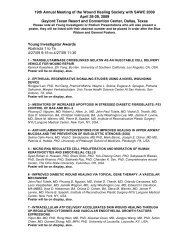

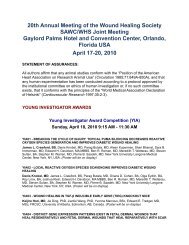
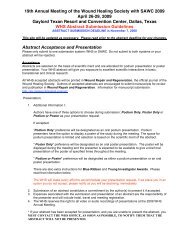
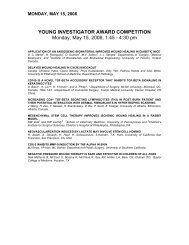



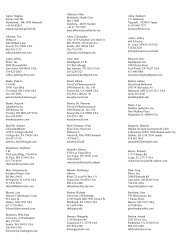
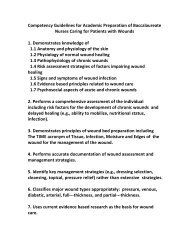
![2010 Abstracts-pah[2] - Wound Healing Society](https://img.yumpu.com/3748463/1/190x245/2010-abstracts-pah2-wound-healing-society.jpg?quality=85)